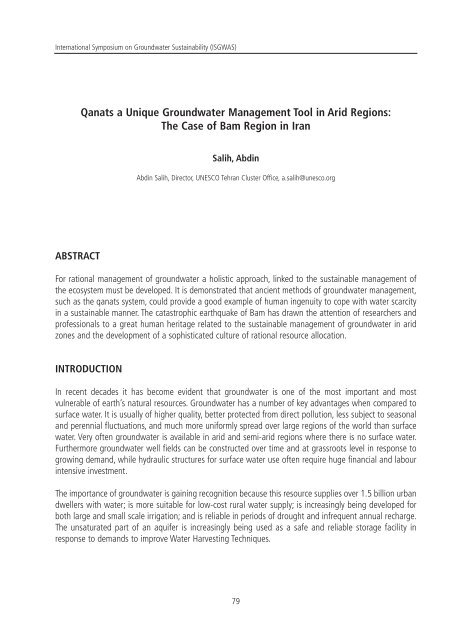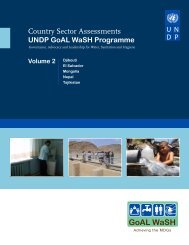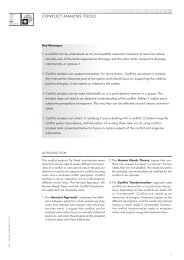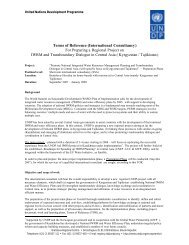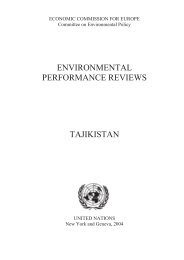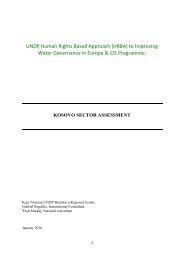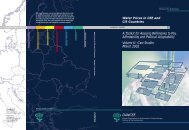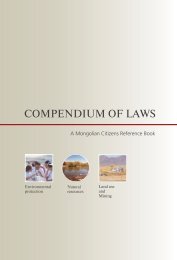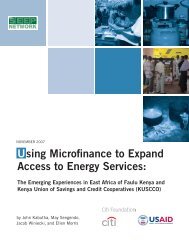Qanats a Unique Groundwater Management Tool in Arid Regions ...
Qanats a Unique Groundwater Management Tool in Arid Regions ...
Qanats a Unique Groundwater Management Tool in Arid Regions ...
Create successful ePaper yourself
Turn your PDF publications into a flip-book with our unique Google optimized e-Paper software.
International Symposium on <strong>Groundwater</strong> Susta<strong>in</strong>ability (ISGWAS)<strong>Qanats</strong> a <strong>Unique</strong> <strong>Groundwater</strong> <strong>Management</strong> <strong>Tool</strong> <strong>in</strong> <strong>Arid</strong> <strong>Regions</strong>:The Case of Bam Region <strong>in</strong> IranSalih, Abd<strong>in</strong>Abd<strong>in</strong> Salih, Director, UNESCO Tehran Cluster Office, a.salih@unesco.orgABSTRACTFor rational management of groundwater a holistic approach, l<strong>in</strong>ked to the susta<strong>in</strong>able management ofthe ecosystem must be developed. It is demonstrated that ancient methods of groundwater management,such as the qanats system, could provide a good example of human <strong>in</strong>genuity to cope with water scarcity<strong>in</strong> a susta<strong>in</strong>able manner. The catastrophic earthquake of Bam has drawn the attention of researchers andprofessionals to a great human heritage related to the susta<strong>in</strong>able management of groundwater <strong>in</strong> aridzones and the development of a sophisticated culture of rational resource allocation.INTRODUCTIONIn recent decades it has become evident that groundwater is one of the most important and mostvulnerable of earth’s natural resources. <strong>Groundwater</strong> has a number of key advantages when compared tosurface water. It is usually of higher quality, better protected from direct pollution, less subject to seasonaland perennial fluctuations, and much more uniformly spread over large regions of the world than surfacewater. Very often groundwater is available <strong>in</strong> arid and semi-arid regions where there is no surface water.Furthermore groundwater well fields can be constructed over time and at grassroots level <strong>in</strong> response togrow<strong>in</strong>g demand, while hydraulic structures for surface water use often require huge f<strong>in</strong>ancial and labour<strong>in</strong>tensive <strong>in</strong>vestment.The importance of groundwater is ga<strong>in</strong><strong>in</strong>g recognition because this resource supplies over 1.5 billion urbandwellers with water; is more suitable for low-cost rural water supply; is <strong>in</strong>creas<strong>in</strong>gly be<strong>in</strong>g developed forboth large and small scale irrigation; and is reliable <strong>in</strong> periods of drought and <strong>in</strong>frequent annual recharge.The unsaturated part of an aquifer is <strong>in</strong>creas<strong>in</strong>gly be<strong>in</strong>g used as a safe and reliable storage facility <strong>in</strong>response to demands to improve Water Harvest<strong>in</strong>g Techniques.79
<strong>Qanats</strong> a <strong>Unique</strong> <strong>Groundwater</strong> <strong>Management</strong> <strong>Tool</strong> <strong>in</strong> <strong>Arid</strong> <strong>Regions</strong>: The Case of Bam Region <strong>in</strong> IranThese advantages, coupled with groundwater’s comparative <strong>in</strong>sulation from direct pollution, have resulted<strong>in</strong> the widespread use of groundwater as the major or even the only source of domestic water <strong>in</strong> manycountries <strong>in</strong> the world. Favour<strong>in</strong>g groundwater <strong>in</strong> domestic use is not only very important <strong>in</strong> arid zones, butalso <strong>in</strong> many regions where surface water is abundant. For example <strong>in</strong> groundwater use exceeds 70 percentof the total water consumption <strong>in</strong> many European countries.In arid and semi arid countries, groundwater is widely used for irrigation. About one-third of the world’slandmass is irrigated by groundwater; <strong>in</strong> the USA 45 percent of cultivated land is irrigated by groundwater,while percentages for Iran, Algeria and Morocco stand at 58, 67 and 75 percent respectively. In some aridand semi-arid countries such as Libya or Tunisia, groundwater is the only traditional source of fresh waterfor all purposes.<strong>Groundwater</strong>’s renewability as part of the hydrological cycle is the pr<strong>in</strong>ciple difference from other m<strong>in</strong>eralresources. Nonetheless groundwater is closely related to other components of the environment; anychanges <strong>in</strong> atmospheric precipitation <strong>in</strong>evitably cause changes <strong>in</strong> the groundwater regime, quantity andquality. And vice versa, changes <strong>in</strong> groundwater cause changes <strong>in</strong> the environment. Thus, <strong>in</strong>tensivegroundwater exploitation can cause a decrease of surface water discharge, land surface subsidence and awilt<strong>in</strong>g of vegetation cover.<strong>Groundwater</strong> and its formations are vulnerable to many forms of contam<strong>in</strong>ation, ma<strong>in</strong>ly by humanactivities although harmful substances are sometimes <strong>in</strong>troduced by natural processes. Irrationalgroundwater abstraction can trap brackish groundwater <strong>in</strong> deep aquifers and draw <strong>in</strong> sal<strong>in</strong>e seawater <strong>in</strong>coastal areas. Susta<strong>in</strong>able groundwater management must be based not only on prevention of theoverexploitation of groundwater resources but also on prevention of contam<strong>in</strong>ation.<strong>Groundwater</strong> pollution is usually a direct result of pollution to the environment, ma<strong>in</strong>ly by sulphates,chlorides, nitrogen compounds, petroleum products, phenols, iron compounds and heavy metals. Oilproducts and <strong>in</strong>dustrial wastes, for example, has caused widespread pollution, while <strong>in</strong>tensive use ofpesticides and fertilizers <strong>in</strong>creas<strong>in</strong>gly threatens many aquifers.<strong>Groundwater</strong> pollution is a serious problem which requires a global consensus on ways to halt currenttrends, <strong>in</strong>clud<strong>in</strong>g a strict ‘Polluter Pays’ policy with effective enforcement mechanisms. Determ<strong>in</strong><strong>in</strong>g thelimits of admissible groundwater withdrawal is however a tricky question. On the one hand there is a needto harvest as much good quality groundwater as possible while on the other there is a need to avoidextreme depletion. This question is further complicated when consider<strong>in</strong>g non-renewable groundwater <strong>in</strong>arid zones with limited alternative water resources.Theoretically groundwater constitutes the bulk of the world’s freshwater resources, but its actualaccessibility is qualified by logistical issues of extraction. It is repeatedly reported that about 2,500 to3,500 BCM of groundwater are annually renewable, out of which only 750-800 BCM per year are currentlyused (Takeuchi and Murthy, 1994). Most of the 750-800 BCM per annum of global groundwaterwithdrawals are used for irrigation of agricultural crops (Shah et aI, 2000). Dur<strong>in</strong>g the last two decades,there has been a significant <strong>in</strong>crease <strong>in</strong> the use of groundwater for irrigation particularly <strong>in</strong> India, the USA,Ch<strong>in</strong>a, Pakistan, Iran and Mexico which are reported as the largest consumers of groundwater (Poste,80
Salih, Abd<strong>in</strong>1999). In these countries, farmers are pump<strong>in</strong>g groundwater faster than its natural replenishment rate,caus<strong>in</strong>g a cont<strong>in</strong>uous drop <strong>in</strong> groundwater tables and depletion of the resource.In arid and semi-arid zones groundwater plays a key role <strong>in</strong> all forms of development and it is extracted,<strong>in</strong>many countries, by deep m<strong>in</strong><strong>in</strong>g of fossil water. In Libya and Saudi Arabia, for example, massive waterm<strong>in</strong><strong>in</strong>g schemes were developed <strong>in</strong> the 1980s and 1990s. In the Arabian Pen<strong>in</strong>sula abstraction from deepaquifers has caused an alarm<strong>in</strong>g depletion of non-renewable groundwater aquifers but <strong>in</strong> urban areasthere are equally alarm<strong>in</strong>g <strong>in</strong>creases <strong>in</strong> the level of contam<strong>in</strong>ated groundwater because of leakage fromwater and wastewater networks and excess irrigation.UNESCO and other <strong>in</strong>ternational bodies recognizes the importance of groundwater as a vital naturalresource. <strong>Groundwater</strong> was a key component <strong>in</strong> the International Hydrological Programme (IHP: 1975 todate). In the Fifth Phase of IHP (1996-2001) groundwater was adopted as the pr<strong>in</strong>cipal priority of theprogramme, play<strong>in</strong>g a prom<strong>in</strong>ent role <strong>in</strong> at least two of its eight themes: “<strong>Groundwater</strong> Resources at Risk”and “Integrated Water Resources <strong>Management</strong> <strong>in</strong> <strong>Arid</strong> and Semi-<strong>Arid</strong> Zones”. This focus cont<strong>in</strong>ues <strong>in</strong> thecurrent phase of the IHP (2002-2007), which conta<strong>in</strong>s <strong>in</strong>itiatives related to shared aquifers (ISARM), acentre for Global <strong>Groundwater</strong> Assessment (IGRAC), develop<strong>in</strong>g isotope hydrology techniques (JIIHP),management of groundwater <strong>in</strong> arid and semi arid zones (G-WADI), regional networks on Wadi Hydrologyand <strong>Groundwater</strong> Protection <strong>in</strong> the Arab region, regional centres for tra<strong>in</strong><strong>in</strong>g water resources management<strong>in</strong> arid and semi arid zones <strong>in</strong> Egypt and Chili, and an International Centre for <strong>Qanats</strong> and HistoricHydraulic Structures <strong>in</strong> the city of Yazd <strong>in</strong> Iran.As with any natural resource, the management of groundwater <strong>in</strong>volves reconcil<strong>in</strong>g supply with demand.This paper focuses on the capacity of ancient systems of groundwater management to adapt to chang<strong>in</strong>gdemands <strong>in</strong> the face of both rapid growth <strong>in</strong> human demand and the shock of a natural disaster. Specialattention is given to the qanats of the city of Bam and the impact of the devastat<strong>in</strong>g earthquake ofDecember 2003.DEFINITION OF QANATSA qanat is a system of water supply consist<strong>in</strong>g of an underground tunnel connected to the surface by aseries of shafts which uses gravity to br<strong>in</strong>g water from the water table to the surface (Fig. 1). <strong>Qanats</strong> areusually dug where there is no surface water and were orig<strong>in</strong>ally <strong>in</strong>vented by Iranians.The ma<strong>in</strong>, or mother, well, is generally excavated <strong>in</strong> the mounta<strong>in</strong>s, penetrat<strong>in</strong>g deep <strong>in</strong>to the water table.Water runs down a slightly slop<strong>in</strong>g tunnel, gradually <strong>in</strong>creas<strong>in</strong>g <strong>in</strong> volume until it emerges near farms orcommunities. Water from qanats is brought to the surface where the soil has been enriched by sedimentsfrom alluvial fans. Cultivated land and settlement sites are situated downwards from the po<strong>in</strong>t where thewater surfaces. The immediate outlet, mazhar, is the po<strong>in</strong>t where people take water and it is generallylocated <strong>in</strong> the ma<strong>in</strong> square of a village. The water outlet po<strong>in</strong>t is very important; it is well kept andcemented and water use is monitored. A tunnel, or payab, channels water under the residential area to thecultivated land. A slop<strong>in</strong>g corridor with steps leads from the surface to the payab. The first payab is located<strong>in</strong> the ma<strong>in</strong> square and is used for tak<strong>in</strong>g dr<strong>in</strong>k<strong>in</strong>g water. A network of smaller payabs runs from the ma<strong>in</strong>payab.81
<strong>Qanats</strong> a <strong>Unique</strong> <strong>Groundwater</strong> <strong>Management</strong> <strong>Tool</strong> <strong>in</strong> <strong>Arid</strong> <strong>Regions</strong>: The Case of Bam Region <strong>in</strong> IranFigure 1 A Typical <strong>Qanats</strong> System<strong>Qanats</strong> are also known as ‘Karez’ (Afghanistan), ’Galeria’ (Spa<strong>in</strong>), ’Khotara’ (Morocco), ’Aflaj’ (ArabianPen<strong>in</strong>sula), ’Foggara’ (North Africa), ’Kanerj<strong>in</strong>g’ (Ch<strong>in</strong>a), ’Auon’ (Saudi Arabia/Egypt), reflect<strong>in</strong>g thewidespread dissem<strong>in</strong>ation of the technology across ancient trad<strong>in</strong>g routes and political maps.QANATS AND GROUNDWATER MANAGEMENT<strong>Qanats</strong> are mostly dug <strong>in</strong> places where there is no permanent and reliable water on the surface.Techniquesfor digg<strong>in</strong>g qanats date back some 5000 years or more <strong>in</strong> Iran and the structure has tremendous social aswell as practical significance. Comprehensive, <strong>in</strong>tegrated and multi-dimensional systems of water use weredeveloped <strong>in</strong> many villages and towns and were regulated by customary laws, some of which were writtendown. Different qanats sometimes have different systems of water use for domestic consumption and forirrigation.The follow<strong>in</strong>g key issues are essential when us<strong>in</strong>g qanats as a groundwater management tool:1) It is important to make sure that the water table is adequate to ensure permanency and susta<strong>in</strong>abilityof water supply as the first step <strong>in</strong> the plann<strong>in</strong>g phase;2) Practical knowledge of local groundwater should be secured among local moghannis (qanat diggers).Although this is empirical and based on land formation, colour and smell of the soil and mounta<strong>in</strong>rocks, natural slope of the land and specific vegetation, experience also plays an important role.3) Modern geological techniques, Geographical Information Systems (GIS) and Remote Sens<strong>in</strong>g (RS)<strong>in</strong>struments can contribute to the restoration and reconstruction of qanats. To enable people to<strong>in</strong>corporate modern scientific approaches <strong>in</strong> their traditional knowledge networks requires preparatoryresearch, tra<strong>in</strong><strong>in</strong>g and appropriate support.82
Salih, Abd<strong>in</strong>4) The recharge process of the supply<strong>in</strong>g aquifer should be known, conserved and cont<strong>in</strong>uously enhancedthrough artificial recharge if necessary. There are places where special dams were built <strong>in</strong> order toenrich the water table. The Iranian qanats of Jandaq for example, are fed by two ancient dams, one ofwhich is claimed to be the second largest “Underground Dam” <strong>in</strong> the world, at 25m long, 1.5m wideand 7m deep.5) In some areas of Central Iran, around Khoor, people dug wells 3-5 meters deep and 5-7m wide andfilled them up with large stones found on flood beds. They directed the floodwaters to these artificialpools to enrich the water table. This ancient recharg<strong>in</strong>g <strong>in</strong>novation can still be used to replenishgroundwater <strong>in</strong> many places.6) <strong>Qanats</strong> can be used as an educational facility for students, technicians, professionals and researchersas well as the general public.QANATS IN THE WORLD AND IN IRANQanat technology exists <strong>in</strong> more than 34 countries <strong>in</strong> the world, but most are concentrated <strong>in</strong> present dayIran, which has about 32164 active systems with a total discharge of about n<strong>in</strong>e billion cubic meters (m3)(Fig. 2). The first recorded qanats were dug <strong>in</strong> the north-western areas of Iran and date back to 800 BC(Western calendar).S<strong>in</strong>ce Iran has few perennial rivers and surface water resources, many of its communities have dependedon qanats for thousands of years. This unique and environmentally susta<strong>in</strong>able system has created culturaland natural ecosystems that ideally addressed the specific needs of each community. Digg<strong>in</strong>g qanats<strong>in</strong>volves a huge amount of work and eng<strong>in</strong>eer<strong>in</strong>g skills orig<strong>in</strong>ally developed <strong>in</strong> Iran and exported acrossthe world.Figure 2. Distribution of <strong>Qanats</strong> <strong>in</strong> the World (Blue colour)83
<strong>Qanats</strong> a <strong>Unique</strong> <strong>Groundwater</strong> <strong>Management</strong> <strong>Tool</strong> <strong>in</strong> <strong>Arid</strong> <strong>Regions</strong>: The Case of Bam Region <strong>in</strong> IranThe qanats of Iran have a special niche <strong>in</strong> the cultural, social, economic, political and physical landscapesof the country.Without these k<strong>in</strong>ds of hydraulic structures, thousands of villages and towns would not havebeen theme at all. Although life <strong>in</strong> Iran has changed radically over the centuries, qanats have ma<strong>in</strong>ta<strong>in</strong>edtheir importance and significance at the heart of community well-be<strong>in</strong>g and survival of many communities<strong>in</strong> that country.QANATS OF BAMOn December 26, 2003 a powerful earthquake struck Kerman prov<strong>in</strong>ce <strong>in</strong> south-central Iran (Fig. 3), kill<strong>in</strong>g26,000 people, <strong>in</strong>jur<strong>in</strong>g many more and almost totally destroy<strong>in</strong>g the historical structures of the city ofBam. The earthquake also brought world attention on the wealth of that region’s hydrogeological,archaeological and geo-historical culture, which had been well known to the ancient world but forgotten<strong>in</strong> the global rush towards modernity.Fig. 3. Location Map of BamWith<strong>in</strong> days after the disaster a huge <strong>in</strong>ternational relief effort was launched. At first, efforts were focusedon sav<strong>in</strong>g lives and provid<strong>in</strong>g emergency services but once the situation had stabilized, attention movedto broader <strong>in</strong>terventions to strengthen traumatized communities’ cultural and social capacities to copewith the disaster and to rebuild the <strong>in</strong>frastructure necessary for them to re-establish their livelihoods andtheir lives.Studies undertaken soon after the earthquake revealed thousands of hectares of archaeological rema<strong>in</strong>s;these had not been dis<strong>in</strong>terred by the violent actions of the earthquake but had been scattered across thesurface, abandoned for hundreds of years. Ongo<strong>in</strong>g archaeological <strong>in</strong>vestigations reveal that the area iseven more significant than had been believed when UNESCO was prepar<strong>in</strong>g the Bam dossier forsubmission to UNESCO’s World Heritage Centre. The Bam area seems to conta<strong>in</strong> the oldest extant qanats<strong>in</strong> Iran and perhaps <strong>in</strong> the world.84
Salih, Abd<strong>in</strong>The technical advantages of the natural sett<strong>in</strong>g of Bam, which is located on a pla<strong>in</strong> between two rangesof mounta<strong>in</strong>s, were progressively understood and exploited by men who played if not the lead<strong>in</strong>g role, atleast a significant part <strong>in</strong> the process of the <strong>in</strong>vention and development of qanats.WATER RESOURCES IN BAMAccord<strong>in</strong>g to available records 170km of semi-conf<strong>in</strong>ed aquifer stretches across the middle areas of theBam-Narmashir pla<strong>in</strong> lead<strong>in</strong>g to a conf<strong>in</strong>ed part beside a shallow unconf<strong>in</strong>ed aquifer (Fig. 4). The watertable, <strong>in</strong> 1993-95, had been accessible at 85m <strong>in</strong> the north and 32m <strong>in</strong> the south at the <strong>in</strong>let section andabout three meters at the outlet section. This hydraulic balance is now disturbed due to the decl<strong>in</strong>e of thewater table.Fig. 4. Schematic Geological Cross Section of the Bam RegionGenerally speak<strong>in</strong>g, sediment content <strong>in</strong> the southern Bam-Narmashir bas<strong>in</strong> is less than the north. Thecloser we get to the Barez mounta<strong>in</strong>s; the deeper the water table becomes. Analysis carried out <strong>in</strong> thesummer of 2002 showed that the electrical conductivity (EC) of Doulat-Abad Qanat was 297micromous/cm while the Jahr-Sadat-Abad Qanat suffered from an extreme EC value of 4,940micromous/cm. One of the reasons for this seemed to be the movement of groundwater through differentformations and the development of a steep hydraulic gradient.Bam District is a typical desert oasis with an average annual ra<strong>in</strong>fall of about 60mm; <strong>in</strong> recent years thishas decreased. This means that crops and trees required irrigation, especially <strong>in</strong> the hot spr<strong>in</strong>g and summermonths. Perennial surface water is non-existent, though there are few permanent dry riverbeds (wadis) and<strong>in</strong>cidental floods dur<strong>in</strong>g the ra<strong>in</strong>y season.The groundwater situation is quite complex. The district is surrounded by high mounta<strong>in</strong>s that receiveprecipitation, both as ra<strong>in</strong> and snow, which <strong>in</strong>filtrates <strong>in</strong>to the alluvial fan and recharges the aquifers85
<strong>Qanats</strong> a <strong>Unique</strong> <strong>Groundwater</strong> <strong>Management</strong> <strong>Tool</strong> <strong>in</strong> <strong>Arid</strong> <strong>Regions</strong>: The Case of Bam Region <strong>in</strong> Iranoverly<strong>in</strong>g the impermeable, f<strong>in</strong>e-gra<strong>in</strong>ed alluvial deposits. This situation was ideal for the construction ofshallow wells and qanat systems. The area has the oldest qanats of Iran and one of the greatest densitiesof qanats <strong>in</strong> the whole country. There are some 375 l<strong>in</strong>es of old traditional qanats and 950 wells ofdifferent depths <strong>in</strong> various parts of the district, about 118 of which are <strong>in</strong> the Bam-Baravat region. Thedischarge rates of the qanats vary widely, mostly <strong>in</strong> the range of 50-200 l.s -1 , while discharges from thosewells are <strong>in</strong> the range of 15-50 l.s -1 . These two means of exploit<strong>in</strong>g groundwater provide millions of m 3 forirrigation. Water quality is generally good and water sal<strong>in</strong>ity is not a problem for the types of crops grownthere.The Bam Fault Scarp has helped to trap groundwater <strong>in</strong> the upper terrace, where Bam city is located, andhas formed a sort of underground dam that keeps recharge water <strong>in</strong> the aquifer and contributes to theqanat systems. Recent geological studies have shown that the 2003 earthquake did not result <strong>in</strong> significantdisplacement of the fault scarp; therefore, it is not expected to have changed groundwater status <strong>in</strong> thearea.UNESCO’S CONTRIBUTION TO THE QANATS OF BAMPrior to the earthquake the qanats of Bam played a major role <strong>in</strong> groundwater management and irrigationof the area, provid<strong>in</strong>g over 50 percent of the annual water requirement. The earthquake caused extensivedamage to many parts of the qanats system.UNESCO Tehran Cluster Office took the <strong>in</strong>itiative of support<strong>in</strong>g the efforts of restoration and futuremanagement of the qanats of Bam <strong>in</strong> close collaboration with the Geological Survey of Iran, the IranianCultural Heritage and Tourism Organization (ICHTO), UNDP, the International Centre for <strong>Qanats</strong> andHistoric Hydraulic Structures and the M<strong>in</strong>istry of Jihad-e-Agriculture. Six teams of experts werecommissioned to prepare comprehensive technical reports on the current status and future prospects ofthe qanats of Bam from the po<strong>in</strong>ts of view of eng<strong>in</strong>eer<strong>in</strong>g, management, culture, archaeology, geology,agriculture and socio-economic. Their results were discussed and <strong>in</strong>tegrated <strong>in</strong> the f<strong>in</strong>d<strong>in</strong>gs of a workshop,the goal of which was to def<strong>in</strong>e a holistic strategy for the repair and management of the qanats of Bamwhich could be seen as a pilot for other regions and countries. This forum, which was held <strong>in</strong> Bam itself,also provided an opportunity for the people of Bam to express their views and concerns.CONCLUSION<strong>Groundwater</strong> management, particularly <strong>in</strong> arid regions, should be viewed holistically and l<strong>in</strong>ked to thesusta<strong>in</strong>able management of the ecosystem. Only through consideration of the <strong>in</strong>teraction between thegroundwater and other environmental components can it be possible to elaborate a long-term programfor rational groundwater use and protection. Ancient methods of groundwater management, such as theqanats system, provide an excellent demonstration of human <strong>in</strong>genuity to cope with water scarcity. Thecatastrophic earthquake of Bam has drawn the attention of researchers and professionals to a greathuman heritage related to the susta<strong>in</strong>able management of groundwater <strong>in</strong> arid zones and thedevelopment of a sophisticated culture of rational resource allocation.86
Salih, Abd<strong>in</strong>ACKNOWLEDGEMENTSThe author would like to thank Professor Morteza Honari a UNESCO Tehran Consultant, Eng. AlirezaSalamat of RCUWM, Ms Niloofar Sadeghi and Ms Jacky Sutton of UNESCO Tehran Office for the materialand assistance provided <strong>in</strong> the preparation of this contribution.REFERENCESAdle, C. (2005), <strong>Qanats</strong> of Bam: Irrigation System <strong>in</strong> Bam from Prehistory to Modern time, Papers of the NationalWorkshop on <strong>Qanats</strong> of Bam, Bam – Iran, UNESCO Tehran Office;Ansari, F. Bolourchi, M.J., Entezam, I. (2005), <strong>Qanats</strong> of Bam, Geological Characteristics of Bam, Papers of the NationalWorkshop on <strong>Qanats</strong> of Bam, Bam - Iran, UNESCO Tehran Office;Kahlown, M.A., Aslam, M. (2005). The Challenges and Opportunities for Environmentally Susta<strong>in</strong>able <strong>Management</strong> of<strong>Groundwater</strong> Resources, A Case Study of the Indus Bas<strong>in</strong> of Pakistan. Papers of the Regional Workshop on Tra<strong>in</strong><strong>in</strong>gof Tra<strong>in</strong>ers on <strong>Management</strong> of Aquifer Recharge and Water Harvest<strong>in</strong>g, Lahore, Pakistan, PCRWR;Kovalevsky, V.S; Kruseman, G.P.; Rushton, K.R. (editors), <strong>Groundwater</strong> Studies, (2004), United Nations Educational,Scientific and Cultural Organization (UNESCO). IHP-VI series on <strong>Groundwater</strong>;Mehrabian, H., Dargahi, B. (2005), <strong>Qanats</strong> of Bam: <strong>Management</strong> and Agricultural Perspectives, Papers of the NationalWorkshop on <strong>Qanats</strong> of Bam, Bam – Iran, UNESCO Tehran Office;Mokhtari, E., Barkhordar, A.A., (2005), <strong>Qanats</strong> of Bam: Recovery of Bam Cultural Heritage, Papers of the NationalWorkshop on <strong>Qanats</strong> of Bam, Bam – Iran, UNESCO Tehran Office;Semsar, A., Labbaf, M., Dehghan, B., (2005), <strong>Qanats</strong> of Bam: An Eng<strong>in</strong>eer<strong>in</strong>g Perspective, Papers of the NationalWorkshop on <strong>Qanats</strong> of Bam, Bam - Iran, UNESCO Tehran Office;Siadat, H., (2005), <strong>Qanats</strong> of Bam: A Socio-Economic Perspective, Papers of the National Workshop on <strong>Qanats</strong> of Bam,Bam – Iran, UNESCO Tehran Office;Zaporozec, A. (editor), <strong>Groundwater</strong> Contam<strong>in</strong>ation Inventory, (2004), United Nations Educational, Scientific andCultural Organization (UNESCO). IHP-VI series on <strong>Groundwater</strong>;Zektser, I.S. Everette, L.G. <strong>Groundwater</strong> Resources of the World and Their Use (2004), United Nations Educational,Scientific and Cultural Organisation (UNESCO), IHP-VI Series on <strong>Groundwater</strong>.87


